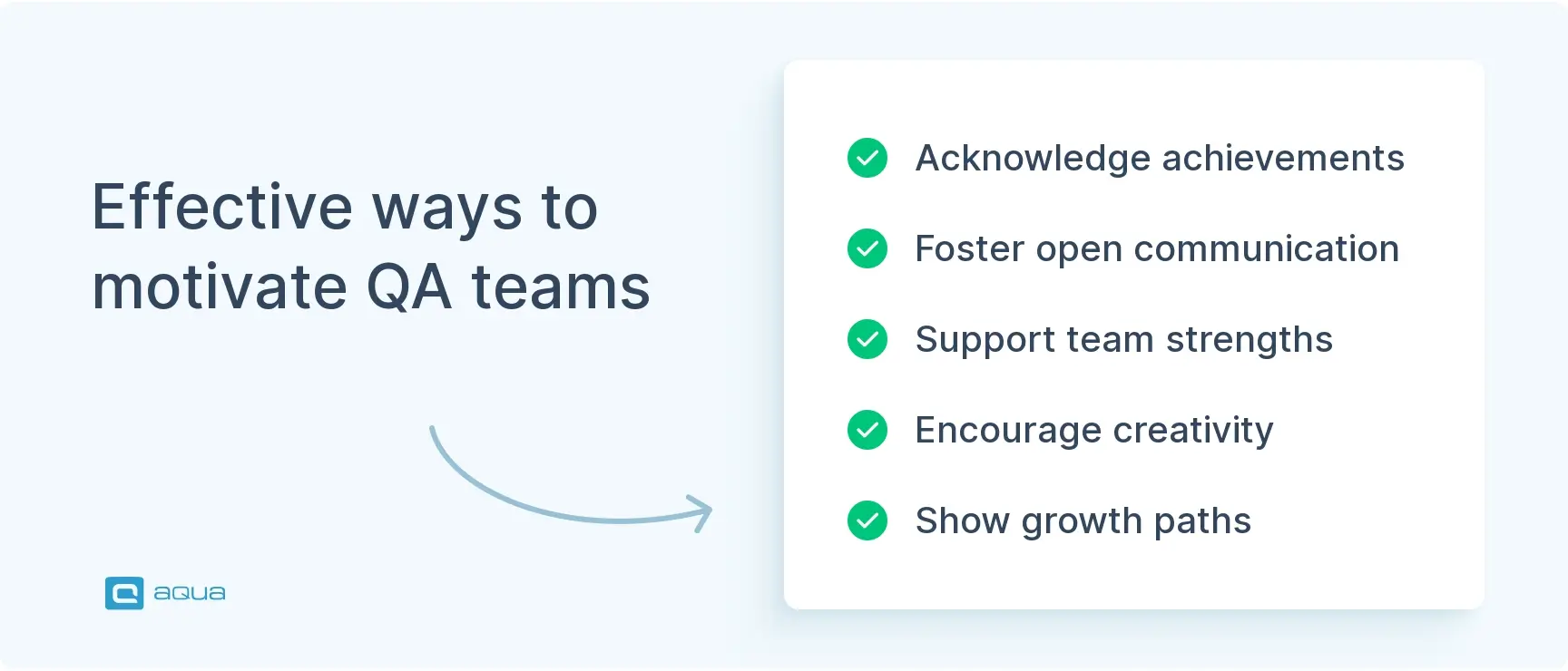You must put in so much effort to manage a QA team effectively. And the same thing comes over when we talk about how to motivate test teams. But it’s much easier if you know the key facts of QA team management. We described them in our article about the QA manager pitfalls to avoid.
Why is QA team motivation important?
Have you ever tried to accomplish anything in your life without proper motivation? Probably not. Motivation is the basis of every successful affair. And as QA and development departments are a foundation stone for any business, their motivation has an even bigger significance to business prosperity.
There are three components that make up development and QA teams: humans, technology, and workflows. If any one of these three is out of balance, your team’s motivation levels can suffer. If a team isn’t motivated, the quality of tests will slip, morale will drop even further, and the problem is quickly self-reinforcing.
Tips to increase testing team motivation
You will want to ensure that every single team participant is equipped with everything they need to complete their tasks and ensure that the products ultimately reach the end users.

This can be hard if you lack resources, don’t have experience in this area, or haven’t had enough time to put together an employee manual. Motivated QA teams don’t just hit targets, they shatter them. When your testers feel genuinely invested, quality metrics can jump by nearly 40%.
Give each team member ownership of a specific quality area they can champion. Maybe Sarah becomes your automation advocate, while Mike owns performance testing insights.
Remember, teams with clear ownership report issues 60% faster than those without defined roles. You’ll see the difference within weeks.
Acknowledge and praise their work
We live in a very fast-paced world today, and there is often little time to stop, reflect and appreciate what we have done. Encourage team members to feel valued by praising and acknowledging them.
You will create positive reinforcement by taking some time each day to acknowledge your QA team’s achievements.
For example, in aqua, every Thursday, we say “Thank you” to those team members who helped us during the week and say our “hoorays” to our superstars for even minor achievements.
It helps keep the team motivated in the long run. Appreciation words for testers are critical, especially when it comes from someone they respect and admire.
Favour clear communication
You want your QA team fired up? Start with crystal-clear communication that actually means something. Skip the info-dumping and focus on building shared understanding instead.
Pull your QA folks into those early conversations and think quick daily check-ins or “Three Amigos” sessions where QA, devs, and product owners hash out requirements before anyone writes a single line of code.
Your QA team stops feeling like an afterthought and starts acting like the quality guardians they are. That shift in mindset is everything. Make sure that everyone understands where they’re going wrong so that they can correct their mistakes before things get out of hand:
- Communicate your vision for projects to ensure employees know performance expectations;
- Give relevant QA feedback and make it a two-way street;
- Don’t turn communication into micromanaging your QA team, give freedom to employees.
Keep communication channels open between managers and workers to ensure better managing QA technical teams. This will allow for better conflict resolution as well as clearer lines of communication about expectations for both sides.
Make the most of aqua's agile functionality
Know superpowers of your team people
QA teams are generally made up of individuals with different strengths and weaknesses. So when managing technical teams QA leads should try to accommodate their individual needs as much as possible.
There is a short list of some more off-top tips on how to appreciate QA team members:
- Check in with everyone individually;
- Talk to people about their personal goals and provide various opportunities for self-development;
- Understand that different approaches work for different people.
Make sure everyone on your QA team understands what they’re contributing to the project. It’s important that everyone working on a project understands its broader purpose. In this way, they can feel they’re making an impact with their work through tangible results instead of just being “invisible cogs” in someone else’s machine.
Tailor Your Approach to Different Tester Personalities
Your QA engineers aren’t wired the same way. Some get fired up by wrestling with gnarly, complex scenarios, while others light up when they see how their work makes things better for actual users. Then you’ve got the automation crowd who practically geek out over building systems that run like clockwork.
Get to know what makes each person tick. Match the work to the person when you can – throw your detail-obsessed testers into requirements reviews where they’ll catch things others miss. Let your user advocates sit in on customer feedback calls (they’ll spot patterns you might overlook). Give your automation enthusiasts some time to poke around with new tools or research.
Spend 15 minutes with each team member asking what type of testing energizes them most. Teams that align work with individual strengths see engagement scores jump by nearly 40%. When people feel their unique abilities are recognized and used, they don’t just stay productive – they become invested in the outcome.
Boost the creative environment
Your QA team’s creativity is the secret weapon against burnout. Start simple: dedicate 15 minutes in your next team meeting for process brainstorming—you’ll be surprised how quickly fresh ideas surface.
One team nearly doubled their bug detection rate by letting testers “poke around” beyond standard scripts during exploratory sessions. The key? Actually implement the good suggestions within two weeks, not file them away. Teams that recognize innovative thinking—even small wins like spotting an overlooked edge case—see motivation levels jump significantly.
Watch for this pitfall: don’t let brainstorming become another mandatory task. Keep it loose, celebrate the weird ideas, and your testers will start thinking like problem-solvers instead of checkbox-checkers.
Our advice here is to encourage creativity among your QA team members in order to keep things fresh and exciting for everyone involved (including yourself!). Try team building, contests or bringing some action into testing. For example, motivating teams to automated testing gives them a reason to make it more creative.
Engage them in the process by asking questions like “What do you think about this? What should we do, and how do we manage it for a better result?” Let them make decisions too.
This will help keep morale high while ensuring. As well you can try the next:
- Foster competitive spirit with rewards;
- Allow them to experiment with their work and the ways they do this
A little segue on how the web-based test case management tool aqua cloud can also help with this:
aqua helps reduce redundant actions and tests by reusing already existing test cases. Just edit them when it’s necessary, and it’s ready to go.
Show them the path to grow
Anyone joining your team wants to also see opportunities to grow and improve. Giving your QA team these chances will keep them more motivated and excited. Otherwise, what are they working for? What do they crave? Salary? After some time, even the highest-paid people in the team wish to learn or challenge themselves with something new on their career pathway. So it’s your duty as a manager to keep them hungry for these growth opportunities. Otherwise, they will feel stuck. When people feel stuck, their energy drops. Help them grow by offering new learning paths:
- Let them attend training, courses or webinars;
- Give them mentors within the team;
- Encourage them to explore new areas of testing.
Here’s the thing about keeping your QA team engaged — they need to see where they’re headed, not just what they’re learning today. Set up dual tracks: one for technical mastery, another for leadership development.
Push your team toward ‘pi-shaped’ skills, basically becoming rock-solid experts in two distinct areas instead of spreading thin everywhere. Teams using this approach see retention rates climb by nearly 40%.
Pair each team member with a mentor this week, focusing on either technical depth or career navigation. Most QA professionals who leave cite “no clear advancement path” as their top reason — mentorship fixes this gap fast.
The unexpected benefit? These mentorship connections often spark cross-team collaboration that strengthens your entire testing strategy.
Celebrate small wins
Keeping morale high doesn’t always require big rewards. Sometimes, recognising the little achievements along the way can make a huge difference. Celebrate small wins with your QA team regularly, whether it’s meeting a sprint goal or solving a tricky bug.
A quick shout-out during a meeting or a simple message of appreciation can go a long way. It shows your team that every effort matters, no matter how small. This creates a positive atmosphere and keeps the motivation strong.

Use Visibility and Celebration to Drive Motivation
When your QA team can actually see their impact, motivation skyrockets. Set up simple dashboards that showcase automation coverage and bugs caught – but here’s the twist: include how much time each discovery saved the development team. This unexpected angle transforms bug reports from ‘problems found’ into ‘hours rescued.’ Throw in some friendly competition with awards like ‘Save of the Month’ for whoever catches the most time-consuming issues early. Track one key metric: days between major releases. Teams with visible progress tracking see this number drop by nearly half within six months. Start small – even a shared spreadsheet updated weekly beats having zero visibility into your wins.
Conclusion
Given all the technicalities involved in this QA team management process, we would say that maintaining an individual’s QA motivation is dependent on several factors, such as involvement level, personal motivation, and lack of private problems; and there is no one-size-fits-all solution.
The practice of QA team management will always be a balancing act, where a manager must give careful consideration to every move made to ensure the best possible results. Talk to your HR, and read a couple of books if you want to be prepared for your battle even better. However, following the basics that we described above can significantly simplify motivating your team.
Cut redundant clicks and save time for better testing

















